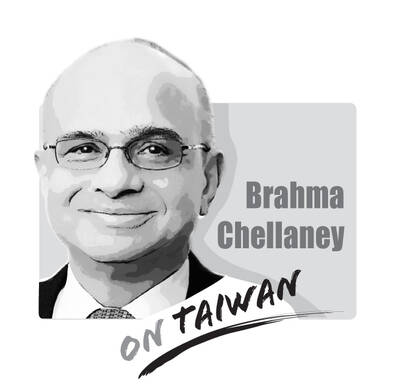The Chiayi City Council passed a motion to assess the possibility of establishing a regulated red-light district in the city. Chiayi Mayor Huang Min-hui (黃敏惠) said that the city government would examine the legality and feasibility of the proposal, but the most important thing is to consult the public.
In 2011, the Social Order Maintenance Act (社會秩序維護法) was amended to allow local governments to set up regulated red-light districts, yet no city mayor or county commissioner has done so. Establishing a red-light district is a sensitive issue, and no officials would want to go against existing social conventions. It is difficult to persuade the public to accept such an arrangement.
Undeniably, the majority of Taiwanese are bound by conventional norms of morality and customs, considering “sex” to be impure and regarding the sex industry with contempt. However, the truth is that the sex industry has existed for a long time in society. Indeed, it never went away.
Sex workers exist in every corner of the globe and have done so for some time. For one thing, people have sexual needs; for another, the sex industry does not disappear with economic growth. No matter how affluent a society is, there are women who live in poverty who face adverse circumstances, perhaps due to unforeseen changes to their lives, and need to take care of their families. To survive, they become sex workers.
Moreover, those who are unmarried, divorced or widowed have sexual needs, so too do the disabled and migrant workers. In this sense, there is a demand in place for such work. The problem is how the public considers this social issue.
In Europe, red-light districts have been established in cities including Germany’s Hamburg and Amsterdam in the Netherlands. Both areas have become popular sightseeing spots. These districts are regulated by the government, and so people’s sexual needs are met and sex workers are protected. With official governance, criminal rings do not have a chance to control and exploit sex workers, whose income and safety is therefore ensured.
Moreover, sexually transmitted diseases such as HIV/AIDS are more effectively managed. It is a triple-win situation for sex workers, clients and the government.
In Taiwan, the issue of establishing regulated red-light districts has been discussed for years. However, even though the Social Order Maintenance Act was revised to legalize it, no red-light district has yet been set up. One of the main reasons is that in Taiwan, officials are afraid of contravening social conventions and affecting children’s upbringing.
The truth is that in Taiwan, everyone knows where a “red-light” area is while pretending there is no such a thing. Everyone behaves as if there were no sex industry in Taiwan. In the cities, it exists in the form of a high-end hotel, guesthouse or club, and in rural areas, it is there, disguised as a restaurant or snack bar. These places are different in appearance and classified differently, but they all provide entertainment and sexual services.
Rather than hiding the issue and avoiding discussion, we should acknowledge it and deal with it. The sex industry should be institutionalized, legalized and brought to light. The most significant problem now is to change the public’s perceptions of the sex industry, which should not be discriminated against. The public’s needs should not be ignored either. The public should understand sex workers’ reasons for engaging in the industry.
The issue of setting up red-light districts must be discussed and considered in a rational and constructive manner.
Shiao Fu-song is a lecturer at National Taitung University.
Translated by Emma Liu

Taiwan stands at the epicenter of a seismic shift that will determine the Indo-Pacific’s future security architecture. Whether deterrence prevails or collapses will reverberate far beyond the Taiwan Strait, fundamentally reshaping global power dynamics. The stakes could not be higher. Today, Taipei confronts an unprecedented convergence of threats from an increasingly muscular China that has intensified its multidimensional pressure campaign. Beijing’s strategy is comprehensive: military intimidation, diplomatic isolation, economic coercion, and sophisticated influence operations designed to fracture Taiwan’s democratic society from within. This challenge is magnified by Taiwan’s internal political divisions, which extend to fundamental questions about the island’s identity and future
Taiwan People’s Party (TPP) Chairman Huang Kuo-chang (黃國昌) is expected to be summoned by the Taipei City Police Department after a rally in Taipei on Saturday last week resulted in injuries to eight police officers. The Ministry of the Interior on Sunday said that police had collected evidence of obstruction of public officials and coercion by an estimated 1,000 “disorderly” demonstrators. The rally — led by Huang to mark one year since a raid by Taipei prosecutors on then-TPP chairman and former Taipei mayor Ko Wen-je (柯文哲) — might have contravened the Assembly and Parade Act (集會遊行法), as the organizers had
Minister of Foreign Affairs Lin Chia-lung (林佳龍) last week made a rare visit to the Philippines, which not only deepened bilateral economic ties, but also signaled a diplomatic breakthrough in the face of growing tensions with China. Lin’s trip marks the second-known visit by a Taiwanese foreign minister since Manila and Beijing established diplomatic ties in 1975; then-minister Chang Hsiao-yen (章孝嚴) took a “vacation” in the Philippines in 1997. As Taiwan is one of the Philippines’ top 10 economic partners, Lin visited Manila and other cities to promote the Taiwan-Philippines Economic Corridor, with an eye to connecting it with the Luzon
The Chinese Nationalist Party (KMT) has postponed its chairperson candidate registration for two weeks, and so far, nine people have announced their intention to run for chairperson, the most on record, with more expected to announce their campaign in the final days. On the evening of Aug. 23, shortly after seven KMT lawmakers survived recall votes, KMT Chairman Eric Chu (朱立倫) announced he would step down and urged Taichung Mayor Lu Shiow-yen (盧秀燕) to step in and lead the party back to power. Lu immediately ruled herself out the following day, leaving the subject in question. In the days that followed, several